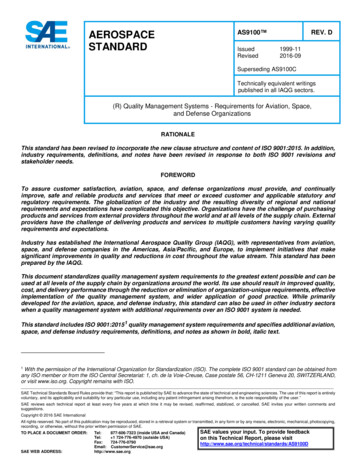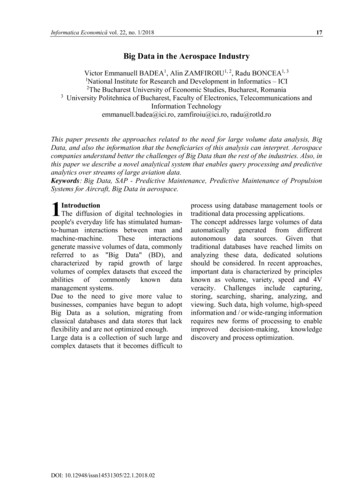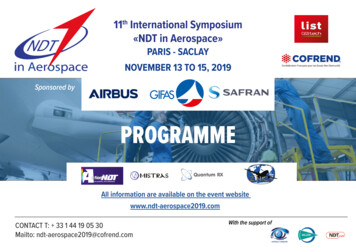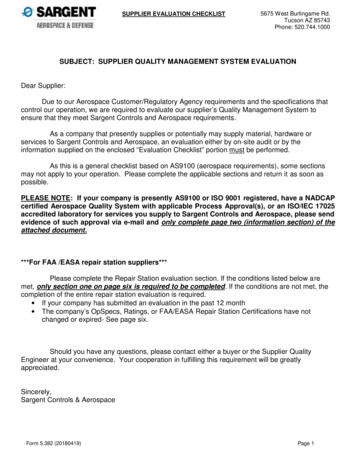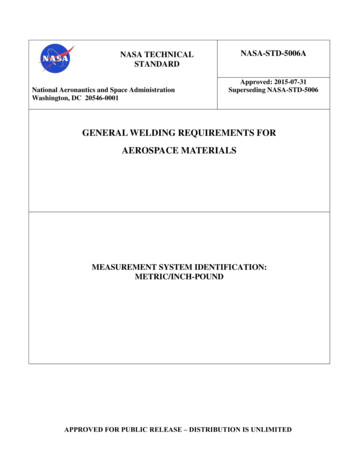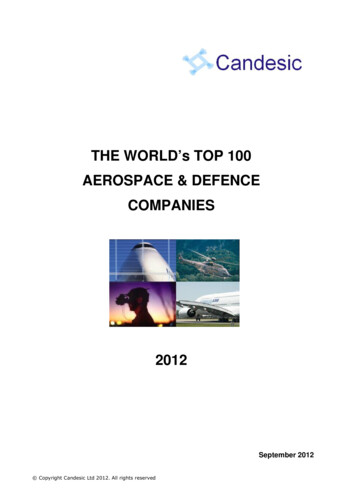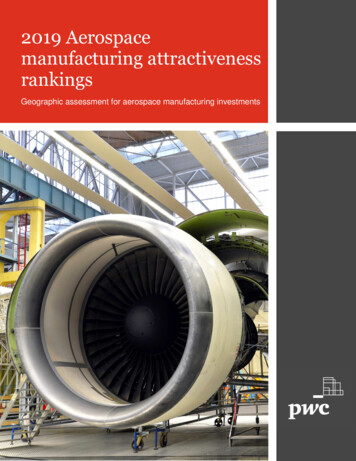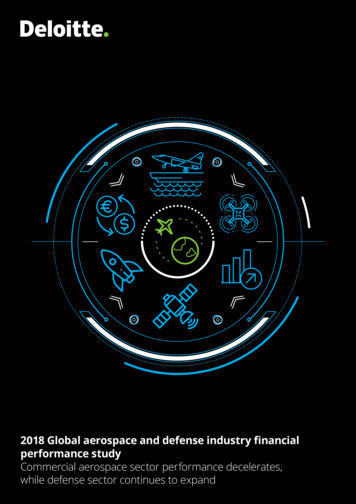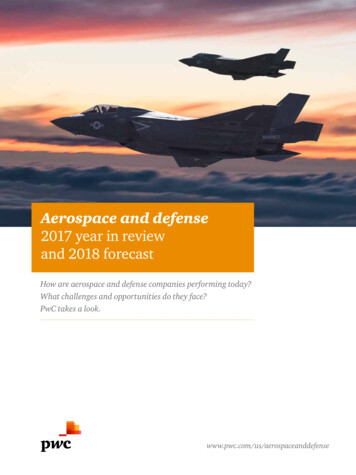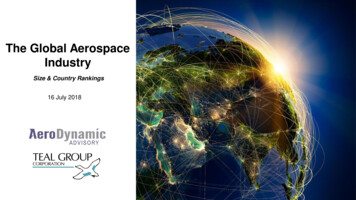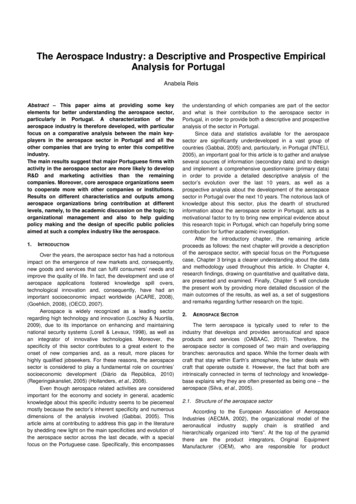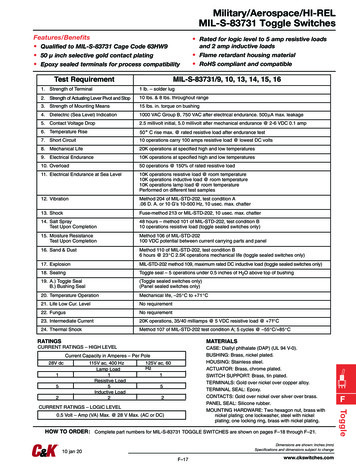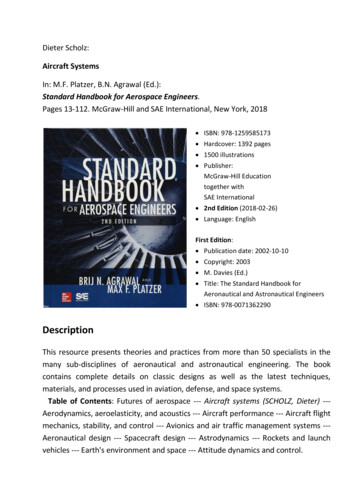
Transcription
Dieter Scholz:Aircraft SystemsIn: M.F. Platzer, B.N. Agrawal (Ed.):Standard Handbook for Aerospace Engineers.Pages 13-112. McGraw-Hill and SAE International, New York, 2018 ISBN: 978-1259585173 Hardcover: 1392 pages 1500 illustrations Publisher:McGraw-Hill Educationtogether withSAE International 2nd Edition (2018-02-26) Language: EnglishFirst Edition: Publication date: 2002-10-10 Copyright: 2003 M. Davies (Ed.) Title: The Standard Handbook forAeronautical and Astronautical Engineers ISBN: 978-0071362290DescriptionThis resource presents theories and practices from more than 50 specialists in themany sub-disciplines of aeronautical and astronautical engineering. The bookcontains complete details on classic designs as well as the latest techniques,materials, and processes used in aviation, defense, and space systems.Table of Contents: Futures of aerospace --- Aircraft systems (SCHOLZ, Dieter) --Aerodynamics, aeroelasticity, and acoustics --- Aircraft performance --- Aircraft flightmechanics, stability, and control --- Avionics and air traffic management systems --Aeronautical design --- Spacecraft design --- Astrodynamics --- Rockets and launchvehicles --- Earth's environment and space --- Attitude dynamics and control.
ional/products/9781259585173SAE ks/content/jp-mgh-001/Amazon (preview):https://www.amazon.com/dp/1259585174 s://www.amazon.com/dp/B079KMCWJC t, the largest library ess for university -second-edition
Standard Handbookfor AerospaceEngineersBrij N. AgrawalEditorMax F. PlatzerEditorSecond EditionNew York Chicago San FranciscoAthens London MadridMexico City Milan New DelhiSingapore Sydney Toronto00 Agrawal FM pi-xxii.indd 104/01/18 6:21 PM
Library of Congress Control Number: 2017957635McGraw-Hill Education books are available at special quantity discounts to use as premiums andsales promotions or for use in corporate training programs. To contact a representative, please visitthe Contact Us page at www.mhprofessional.com.Standard Handbook for Aerospace Engineers, Second EditionCopyright 2018, 2003 by McGraw-Hill Education. All rights reserved. Printed in the UnitedStates of America. Except as permitted under the United States Copyright Act of 1976, no part ofthis publication may be reproduced or distributed in any form or by any means, or stored in a database or retrieval system, without the prior written permission of the publisher.1 2 3 4 5 6 7 8 9 LCR 23 22 21 20 19 18ISBN 978-1-259-58517-3MHID 1-259-58517-4The pages within this book were printed on acid-free paper.The first edition of this book was titled The Standard Handbook for Aeronautical and AstronauticalEngineers.Sponsoring EditorRobert ArgentieriEditing SupervisorStephen M. SmithProduction SupervisorPamela A. PeltonAcquisitions CoordinatorLauren RogersProject ManagersAnubhav Singh andSonam Arora,Cenveo Publisher ServicesCopy EditorSurendra Shivam,Cenveo Publisher ServicesProofreaderBarnali Ojha,Cenveo Publisher ServicesArt Director, CoverJeff WeeksCompositionCenveo Publisher ServicesInformation contained in this work has been obtained by McGraw-Hill Education from sources believed to be reliable. However,neither McGraw-Hill Education nor its authors guarantee the accuracy or completeness of any information published herein, andneither McGraw-Hill Education nor its authors shall be responsible for any errors, omissions, or damages arising out of use of thisinformation. This work is published with the understanding that McGraw-Hill Education and its authors are supplyinginformation but are not attempting to render engineering or other professional services. If such services are required, the assistanceof an appropriate professional should be sought.00 Agrawal FM pi-xxii.indd 204/01/18 6:21 PM
ContributorsBrij N. Agrawal Distinguished Professor, Department of Mechanical and Aerospace Engineering, NavalPostgraduate School, Monterey, California (Secs. 7, 11, 12)Sachin Agrawal Senior Control Engineer, formerly at Space System Loral and Lockheed Martin, Palo Alto,California (Sec. 11)D. N. BakerLaboratory for Atmospheric and Space Physics, University of Colorado, Boulder, Colorado(Sec. 10)Eranga BatuwangalaResearcher, Aerospace Engineering and Aviation Discipline, RMIT University,Bundoora, Victoria, Australia (Sec. 5)Suraj BijjahalliResearcher, Aerospace Engineering and Aviation Discipline, RMIT University, Bundoora,Victoria, Australia (Sec. 5)Frederic Boniol Research Engineer, ONERA, France (Sec. 5)Dominique BrièreHead of Flight Control and Automatic Flight Control Systems Department, Airbus,France (Sec. 5)Dennis M. Bushnell Chief Scientist, NASA Langley Research Center, Hampton, Virginia (Sec. 1)J. P. Catani Head of Department, Power Supply and Electromagnetic Compatibility, Centre Nationald’Etudes Spatiales, France (Sec. 5)Muguru S. Chandrasekhara Research Professor, Department of Mechanical and Aerospace Engineering,Naval Postgraduate School, Monterey, California (Sec. 3)Florent Christophe Deputy Head, Department of Electromagnetism and Radar, ONERA, France (Sec. 5)Jonathan Cooper Professor of Engineering, School of Engineering, University of Manchester, United Kingdom(Sec. 3)Alan R. Crocker Senior System Engineer, NASA Ames Research Center, Moffett Field, California (Sec. 12)M. Crokaert Doctor in Atomic Physics–Engineer, Centre National d’Etudes Spatiales, France (Sec. 5)Atri Dutta Assistant Professor, Aerospace Engineering, Wichita State University, Wichita, Kansas (Sec. 8)Peter Eckart Division of Astronautics, Technical University of Munich, Germany (Sec. 10)John A. EkaterinarisDistinguished Professor, Department of Aerospace Engineering, Embry-RiddleAeronautical University, Daytona Beach, Florida (Sec. 3)Jack Foisseau Head of Modelling and Requirement Engineering, ONERA, France (Sec. 5)Anthony J. Gannon Associate Professor, Department of Mechanical and Aerospace Engineering, NavalPostgraduate School, Monterey, California (Sec. 3)xv00 Agrawal FM pi-xxii.indd 1504/01/18 6:21 PM
xviContributorsAlessandro Gardi Research Officer, Aerospace Engineering and Aviation Discipline, RMIT University,Bundoora, Victoria, Australia (Sec. 5)Guru P. Guruswamy Senior Scientist, NASA Ames Research Center, Moffett Field, California (Sec. 3)Kenneth R. Hamm, Jr. NESC Chief Engineer, NASA Ames Research Center, Moffett Field, California (Sec. 11)Thomas M. Hancock IIIPrivate Consultant, Systems Engineering and Flight Software Safety, Huntsville,Alabama (Sec. 11)Rüdiger Jehn European Space Operation Center, Germany (Sec. 10)Michael W. Jenkins Professor Emeritus of Aerospace Design, Georgia Institute of Technology, Atlanta,Georgia (Sec. 6)Rohan Kapoor Researcher, Aerospace Engineering and Aviation Discipline, RMIT University, Bundoora,Victoria, Australia (Sec. 5)Trevor Kistan Research and Technology Manager, THALES Australia, Melbourne, Victoria, Australia (Sec. 5)Gary H. Kitmacher International Space Station Program, National Aeronautics and Space Administration,Johnson Space Center, Houston, Texas (Sec. 7)G. Komatsu International Research School of Planetary Sciences, Università d’Annunzio, Italy (Sec. 10)Yixiang Lim Researcher, Aerospace Engineering and Aviation Discipline, RMIT University, Bundoora,Victoria, Australia (Sec. 5)Gerald Lo Formerly at INTELSAT, Washington, D.C. (Sec. 11)Louis L. Maack Fellow, Lockheed Martin Space Systems, Sunnyvale, California (Sec. 7)Jean-Claude Mollier Head of Department, Systemes Electronics Photoniques, SUPAERO, France (Sec. 5)Roy Y. Myose Professor of Aerospace Engineering, Wichita State University, Wichita, Kansas (Sec. 8)Andrew J. Niven Senior Lecturer, Department of Mechanical and Aeronautical Engineering, University ofLimerick, Ireland (Sec. 3)Tina L. Panontin Chief Engineer, NASA Ames Research Center, Moffett Field, California (Sec. 12)J. P. Parmantier Doctor/Engineer in Electromagnetism, ONERA, France (Sec. 5)Marc Pélegrin Docteur ès Sciences Automatics, FEDESPACE, France (Sec. 5)Joseph N. PeltonFormer Dean, International Space University, and Executive Board, InternationalAssociation for the Advancement of Space Safety (Sec. 7)Max F. PlatzerDistinguished Professor Emeritus, Department of Mechanical and Aerospace Engineering,Naval Postgraduate School, Monterey, California (Sec. 3)Sylvain Prudhomme Head of Identification and Control Research Group, ONERA, France (Sec. 5)Jeffery J. Puschell Principal Engineering Fellow, Raytheon Company, El Segundo, California (Sec. 11)Subramanian RamasamyResearch Officer, Aerospace Engineering and Aviation Discipline, RMITUniversity, Bundoora, Victoria, Australia (Sec. 5)Michael J. Rycroft Cambridge Atmospheric, Environmental and Space Activities and Research, UnitedKingdom (Sec. 10)Roberto SabatiniProfessor of Aerospace Engineering and Aviation, RMIT University, Bundoora, Victoria,Australia (Sec. 5)Abbas A. Salim Engineering Fellow/Principal Engineer (Retired), Lockheed Martin Space Systems, Denver,Colorado (Sec. 11)00 Agrawal FM pi-xxii.indd 1604/01/18 6:21 PM
ContributorsxviiNesrin Sarigul-Klijn Professor, Department of Mechanical and Aerospace Engineering, University ofCalifornia, Davis, California (Sec. 3)Dieter ScholzProfessor, Aircraft Design and Systems, Hamburg University of Applied Sciences,Germany (Sec. 2)Michael J. SekerakMission Systems Engineer, NASA Goddard Space Flight Center, Greenbelt,Maryland (Sec. 9)Jerry Jon Sellers Senior Space Systems Engineer, Teaching Science and Technology, Inc., Manitou Springs,Colorado (Sec. 9)Stevan M. SpremoSenior Systems Engineer, NASA Ames Research Center, Moffett Field, California(Sec. 12)Constantinos Stavrinidis Former Head of Mechanical Engineering Department, ESTEC, European SpaceAgency, The Netherlands (Sec. 11)Robert Stevens Director of Model-Based Systems Engineering Office, The Aerospace Corporation,El Segundo, California (Sec. 12)Subchan Subchan Vice Rector of Academic Affairs, Kalimantan Institute of Technology, Malaysia (Sec. 4)Douglas G. ThomsonChief Adviser of Studies, School of Engineering, University of Glasgow, UnitedKingdom (Sec. 4)Trevor M. Young Associate Professor, Department of Mechanical and Aeronautical Engineering, Universityof Limerick, Ireland (Sec. 4).Rafał Zbikowski Professor of Control Engineering, Cranfield University, Cranfield, United Kingdom (Sec. 4)00 Agrawal FM pi-xxii.indd 1704/01/18 6:21 PM
About the EditorsDr. Brij N. Agrawal is a Distinguished Professor in the Department ofMechanical and Aerospace Engineering and Director of the SpacecraftResearch and Design Center at the Naval Postgraduate School (NPS). Priorto joining NPS in 1989, he worked for 20 years in the research, design, anddevelopment of communications satellites at COMSAT and INTELSAT.Dr. Agrawal is the author of Design of Geosynchronous Spacecraft. He is aFellow of the American Institute of Aeronautics and Astronautics and aMember of the International Academy of Astronautics.Dr. Max F. Platzer is a Distinguished Professor Emeritus in the Departmentof Mechanical and Aerospace Engineering at the Naval PostgraduateSchool (NPS). Prior to joining NPS in 1970, he was a member of the Saturnspace launch vehicle development team at the NASA Marshall SpaceFlight Center and head of the Aeromechanics Research Group at theLockheed Georgia Research Center. He is a Fellow of both the AmericanInstitute of Aeronautics and Astronautics and the American Society ofMechanical Engineers.About SAE InternationalSAE International (sae.org) is a global association committed to being theultimate knowledge source for the engineering profession. By uniting over127,000 engineers and technical experts, we drive knowledge and expertiseacross a broad spectrum of industries. We act on two priorities: encouraginga lifetime of learning for mobility engineering professionals and settingthe standards for industry engineering. We strive for a better worldthrough the work of our charitable arm, the SAE Foundation, which helpsfund programs like A World in Motion and the Collegiate Design Series .00 Agrawal FM pi-xxii.indd 1804/01/18 6:21 PM
Preface to the Second EditionIn the 15 years since the publication of the first edition of this handbook, many new developmentshave occurred, especially in the astronautics field. We have included them in this second edition,which is divided into three major areas.In the first section the chief scientist of the NASA Langley Research Center presents his view ofthe likely aerospace developments in the coming years. The subsequent five sections provide thereader with an update of the major developments in aeronautics. These include major advances inpredicting and measuring very complex flow phenomena due to the rapid increases in computingpower in recent years. Therefore, parts on computational fluid dynamics, modern flow measuringtechniques, computational aeroelasticity, and computational acoustics have been added to thecoverage of classical aerodynamic analysis methods retained from the first edition. Similarly, a parton optimal control theory was added to the coverage of aircraft performance, stability, and controlin order to draw attention to the progress achieved in this field. This is followed by a major revisionof avionics coverage because, here again, major advances have occurred. Also, in this section newparts on air traffic management have been added. Two sections retained with only minor changescover aircraft systems and aircraft design.The subsequent six sections provide the reader with an update of the major developments inastronautics. The sections titled Astrodynamics, Rockets and Launch Vehicles, and Earth’sEnvironment and Space have been retained from t
Standard Handbook for Aerospace Engineers. Pages 13-112. McGraw-Hill and SAE International, New York, 2018 ISBN: 978-1259585173 Hardcover: 1392 pages 1500 illustrations Publisher: McGraw-Hill Education together with SAE International 2nd Edition (2018-02-26) Language: English First Edition:
